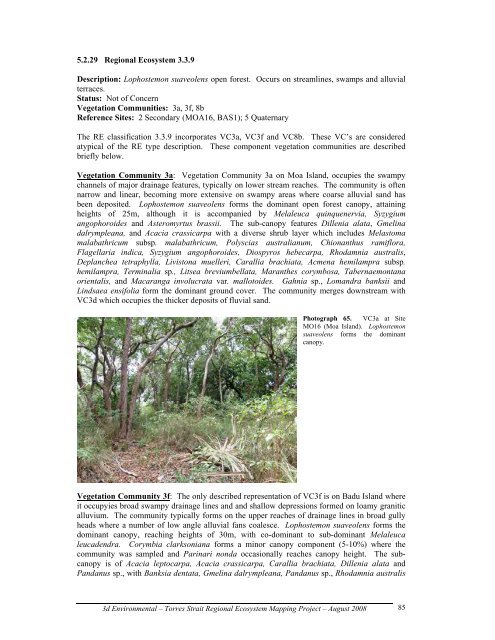Appendix 2 - Vegetation Communities and Regional Ecosystems
Appendix 2 - Vegetation Communities and Regional Ecosystems
Appendix 2 - Vegetation Communities and Regional Ecosystems
You also want an ePaper? Increase the reach of your titles
YUMPU automatically turns print PDFs into web optimized ePapers that Google loves.
5.2.29 <strong>Regional</strong> Ecosystem 3.3.9<br />
Description: Lophostemon suaveolens open forest. Occurs on streamlines, swamps <strong>and</strong> alluvial<br />
terraces.<br />
Status: Not of Concern<br />
<strong>Vegetation</strong> <strong>Communities</strong>: 3a, 3f, 8b<br />
Reference Sites: 2 Secondary (MOA16, BAS1); 5 Quaternary<br />
The RE classification 3.3.9 incorporates VC3a, VC3f <strong>and</strong> VC8b. These VC’s are considered<br />
atypical of the RE type description. These component vegetation communities are described<br />
briefly below.<br />
<strong>Vegetation</strong> Community 3a: <strong>Vegetation</strong> Community 3a on Moa Isl<strong>and</strong>, occupies the swampy<br />
channels of major drainage features, typically on lower stream reaches. The community is often<br />
narrow <strong>and</strong> linear, becoming more extensive on swampy areas where coarse alluvial s<strong>and</strong> has<br />
been deposited. Lophostemon suaveolens forms the dominant open forest canopy, attaining<br />
heights of 25m, although it is accompanied by Melaleuca quinquenervia, Syzygium<br />
angophoroides <strong>and</strong> Asteromyrtus brassii. The sub-canopy features Dillenia alata, Gmelina<br />
dalrympleana, <strong>and</strong> Acacia crassicarpa with a diverse shrub layer which includes Melastoma<br />
malabathricum subsp. malabathricum, Polyscias australianum, Chionanthus ramiflora,<br />
Flagellaria indica, Syzygium angophoroides, Diospyros hebecarpa, Rhodamnia australis,<br />
Deplanchea tetraphylla, Livistona muelleri, Carallia brachiata, Acmena hemilampra subsp.<br />
hemilampra, Terminalia sp., Litsea breviumbellata, Maranthes corymbosa, Tabernaemontana<br />
orientalis, <strong>and</strong> Macaranga involucrata var. mallotoides. Gahnia sp., Lom<strong>and</strong>ra banksii <strong>and</strong><br />
Lindsaea ensifolia form the dominant ground cover. The community merges downstream with<br />
VC3d which occupies the thicker deposits of fluvial s<strong>and</strong>.<br />
Photograph 65. VC3a at Site<br />
MO16 (Moa Isl<strong>and</strong>). Lophostemon<br />
suaveolens forms the dominant<br />
canopy.<br />
<strong>Vegetation</strong> Community 3f: The only described representation of VC3f is on Badu Isl<strong>and</strong> where<br />
it occupyies broad swampy drainage lines <strong>and</strong> <strong>and</strong> shallow depressions formed on loamy granitic<br />
alluvium. The community typically forms on the upper reaches of drainage lines in broad gully<br />
heads where a number of low angle alluvial fans coalesce. Lophostemon suaveolens forms the<br />
dominant canopy, reaching heights of 30m, with co-dominant to sub-dominant Melaleuca<br />
leucadendra. Corymbia clarksoniana forms a minor canopy component (5-10%) where the<br />
community was sampled <strong>and</strong> Parinari nonda occasionally reaches canopy height. The subcanopy<br />
is of Acacia leptocarpa, Acacia crassicarpa, Carallia brachiata, Dillenia alata <strong>and</strong><br />
P<strong>and</strong>anus sp., with Banksia dentata, Gmelina dalrympleana, P<strong>and</strong>anus sp., Rhodamnia australis<br />
3d Environmental – Torres Strait <strong>Regional</strong> Ecosystem Mapping Project – August 2008<br />
85


